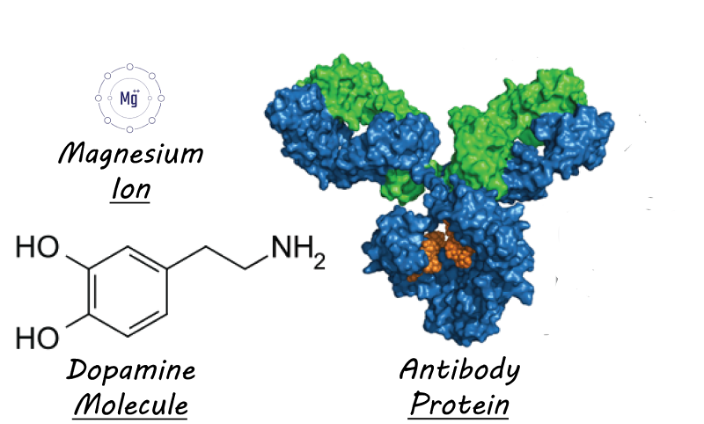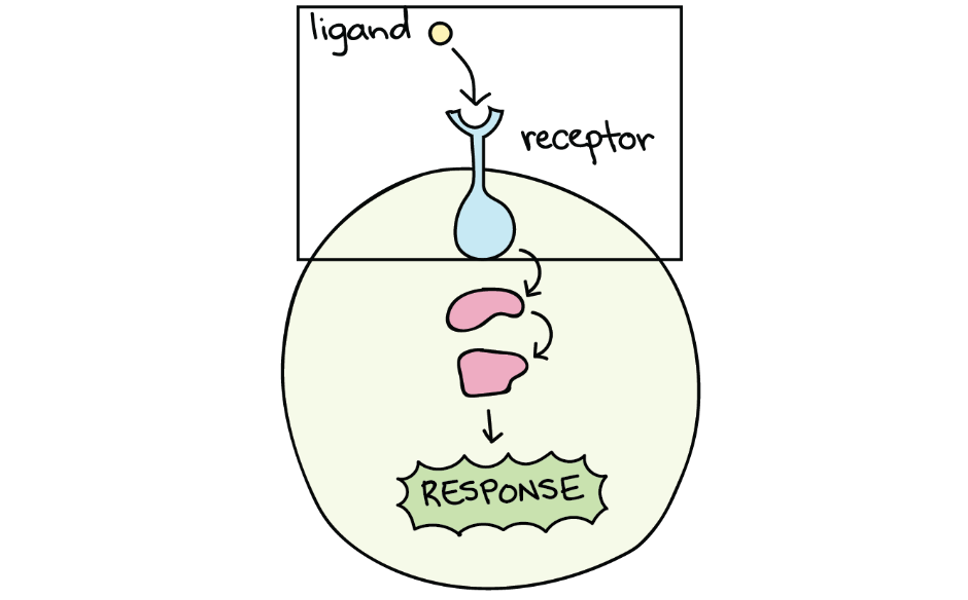By Seth Veenbaas
Ligand
(noun. /LIG-uhnd/)
What does it mean?
In biochemistry, a ligand is a molecule that binds to or sticks on to macromolecules, which are large biological structures in our cells made of protein, DNA, or RNA.

Example of different types of biological ligands ranging from small ions to large antibody proteins.
Ligands come in all shapes and sizes. Some ligands are small ions made of a single atom (i.e. Mg2+ or Na+), others are complex molecules that contain many atoms (i.e. medication, dopamine or hormone), and some are macromolecules which contain thousands of atoms (i.e. a protein or antibody). Ligands have several functions in our cells including sending messages and detecting specific substances. For example, Neurotransmitters, such as dopamine, are ligands that deliver messages sent by some of your brain cells and received by other brain cells in a biological inbox called a receptor. Antibodies are examples of massive ligands made of proteins that stick to forgien substances in your blood and alert your immune system to respond to the intruders.
How do I use it in a sentence?
“The neurotransmitter dopamine is a ligand that binds to the dopamine receptor in the brain.”

Ligand delivers a message to a membrane-bound receptor protein which passes the message to the inside of the cell. –Khan Academy
Etymology
“Ligand” was first used in the early 1950’s and originates from the Latin word ligandus, meaning “that which ties together,” derived from the Latin verb ligare meaning “to bind”.
Related terms
Inhibitor: a special type of ligand that binds to a biologically active macromolecule and prevents it from performing its normal job. Many medications work by inhibiting proteins, and specifically enzymes, in your body. For example, painkillers, like aspirin, bind to pain receptors in your body and prevent them from performing their normal job of telling your brain that you are in pain.
Receptor: a special type of protein that acts like an inbox to receive cellular messages by binding to message carrying ligands. Receptors are often located within the cell membrane and allow messages to be passed from ligands on the outside of the cell to other proteins on the inside of the cell.
Conformational Change: when a protein changes shape due to a ligand binding to it. Similar to how Transformers can change their shape from a car to a robot, proteins can also change shape allowing them to do new things. When a protein changes shape it is usually more subtle than a Transformer but the conformational change can have a large impact on how the protein works in the cell. Conformational change is a very common way for proteins to create a response to a binding ligand and is used by many receptor proteins including the most common type of receptor in your body called a G-protein-coupled receptor.
